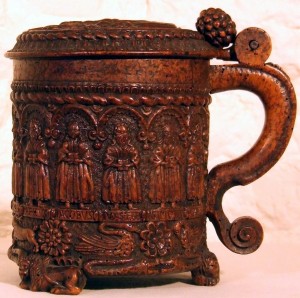The Glastonbury Grace Cup, a 16th century oak tankard intricately carved with images of the 12 Apostles, the crucifixion of Christ, birds, beasts and flowers, is going on display at Glastonbury Abbey, its reputed ancestral home, for the first time since 1886.
 Legend has it that the tankard belonged to the abbots of Glastonbury, the last of whom, Abbot Richard Whiting, was hanged, drawn and quartered in 1539 during the Dissolution of Monasteries. Whiting had been a supporter of King Henry VIII, even signing the 1534 Act of Supremacy that made the king the head of the Church of England, but when Henry’s men showed up to loot Glastonbury Abbey and confiscate its lands, Whiting tried to stop them so they executed him as a traitor on the spot.
Legend has it that the tankard belonged to the abbots of Glastonbury, the last of whom, Abbot Richard Whiting, was hanged, drawn and quartered in 1539 during the Dissolution of Monasteries. Whiting had been a supporter of King Henry VIII, even signing the 1534 Act of Supremacy that made the king the head of the Church of England, but when Henry’s men showed up to loot Glastonbury Abbey and confiscate its lands, Whiting tried to stop them so they executed him as a traitor on the spot.
Grace Cup was smuggled out of the abbey and given for safekeeping to a Catholic branch of the Arundell family of Wardour Castle in Wiltshire, according to Arundell family lore. A hundred years later the tankard had another brush with the pointy end of British history, this time narrowly avoiding destruction when Cromwell’s Parliamentarian forces set siege to Wardour Castle in 1643 during the English Civil War. It was Lady Blanche Arundell, left alone at the castle with only 25 men-at-arms while her husband was off fighting with King Charles, who fended off the attackers for nine days and was able to hide the cup before she finally surrendered.
We can’t know for sure that the tankard came from Glastonbury Abbey. The decoration on the cup suggests that it may have been carved in Germany or elsewhere central Europe. One theory is that the cup was brought to Wardour by Thomas Arundell, 1st Baron Arundell of Wardour, returned from fighting for the Holy Roman Emperor Rudolf II against the Ottoman Turks in 1595. Sir Thomas, nicknamed “the Valiant” for his bravery in taking down the Turkish standard and replacing it with the Imperial one during a battle in Gran, Hungary, could have picked it up during his travels.
However, Sir Thomas was in a shipwreck on his way home from the war and lost everything. He made it to shore with only the clothes on his back, so if the tankard was picked up by an Arundell on the continent rather than saved from the violence of the Dissolution, it probably wasn’t Sir Thomas after fighting the Turks.
Also, this kind of tankard is called a Grace Cup because it was traditionally shared around a table after a prayer of thanksgiving, aka saying grace. On the inside of the cup there are vertical rows of pegs that apportion an equal amount of beverage to each drinker. Add that to its religious decoration and it makes the abbey provenance plausible even setting aside the Arundell family stories.
The cup was tracked down and put on display in Glastonbury in 1886 to celebrate the founding of the Glastonbury Antiquarian Society. Now, to celebrate the society’s 125th birthday, Lord Talbot of Malahide, Arundell descendent and current owner of the cup, is loaning the Grace Cup to the abbey again. The exhibition opens December 14th and runs until January 31th.
